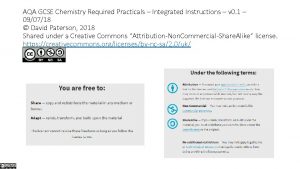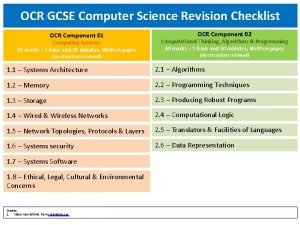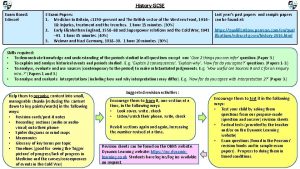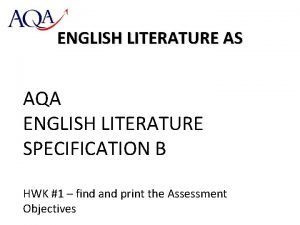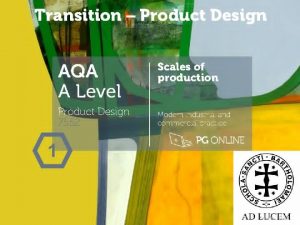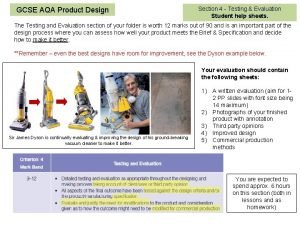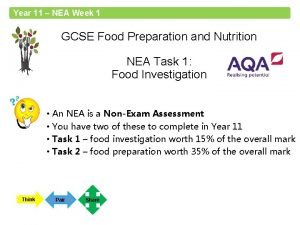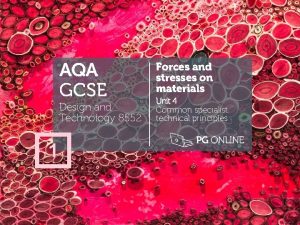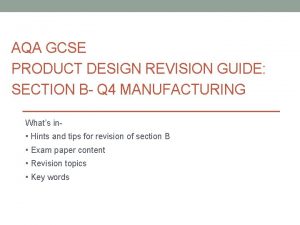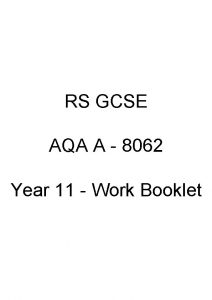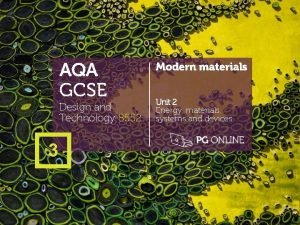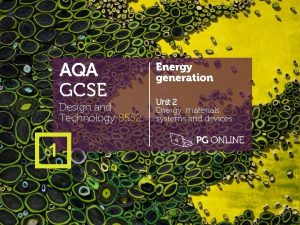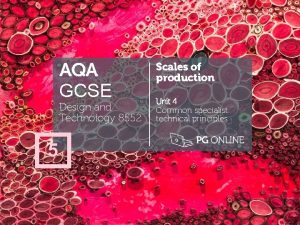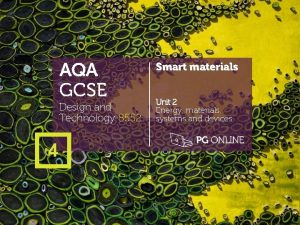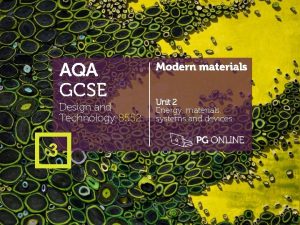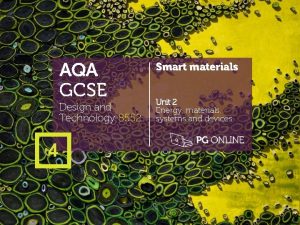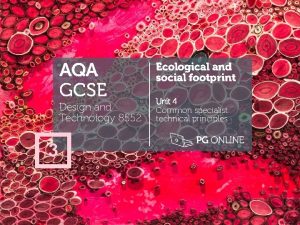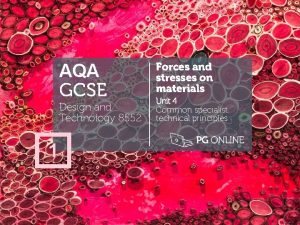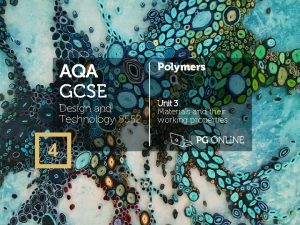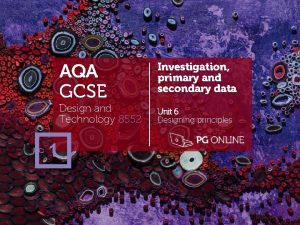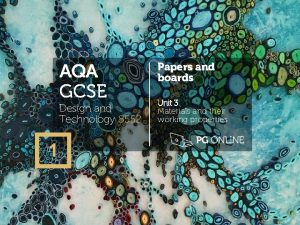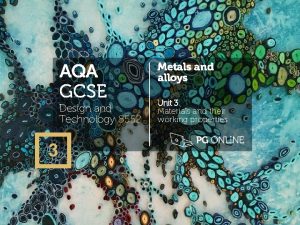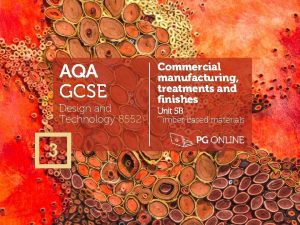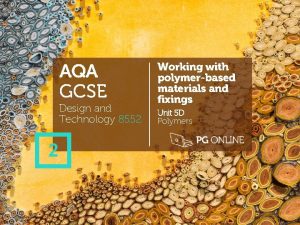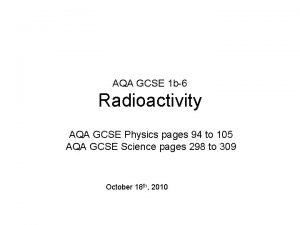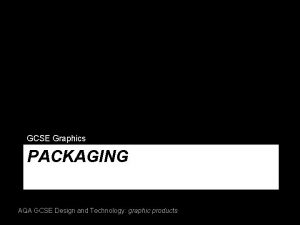AQA GCSE Design and Technology 8552 1 Sources




































- Slides: 36

AQA GCSE Design and Technology 8552 1 Sources, origins and properties Unit 5 D Polymers

Objectives • Know the primary sources of polymers • Understand the processes involved in refining, fractional distillation and cracking to produce workable forms of polymers • Understand how plastics can be modified to enhance their properties • Be aware of sustainability and ethical issues in plastics production, in use and end of life

Sources, origins and properties Unit 5 D Polymers What is plastic? • The word plastic means ‘easily shaped or moulded’ and is derived from the Greek work ‘plastikos’ • Plastics are made from polymers which is a Greek word meaning many: ‘poly’ - parts: ‘mer’ • Plastics are semi-organic and always derived from oil or petroleum • Plastics are synthetic materials. What is meant by synthetic?

Sources, origins and properties Unit 5 D Polymers The origins of plastics • Different polymers are derived from different sources • These can produce different types of plastics: • Natural plastics made from rubber or latex • Bio-plastics made from vegetable starches or algae • Synthetic plastics made from petrochemical sources

Sources, origins and properties Unit 5 D Polymers Natural plastics • There are some naturally occurring plastics: • Amber (fossilised tree resin) and • Latex (a form of rubber) • Natural latex is harvested from the Rubber tree (Hevea Brasiliensis) • The bark is scored (tapped) to allow the milky sap to run out into a container

Sources, origins and properties Unit 5 D Polymers Bioplastics • These are commonly made from corn or vegetable starches • Fully biodegradable if composted • Bacteria in the soil breaks down the plastic quickly • However, they cannot be recycled in a traditional way • Why not?

Sources, origins and properties Unit 5 D Polymers Synthetic plastics • Synthetic plastics are made from polymers • These come from finite petrochemical resources; usually crude oil • Plastics can also be derived from natural gas and coal

Sources, origins and properties Unit 5 D Polymers Producing polymers • Polymers are produced through a lengthy process called refining • Unprocessed (crude) oil is first extracted from underground, either at sea using an oil rig, or on land • It is then transported to a plant for conversion

Sources, origins and properties Unit 5 D Polymers Refining crude oil • Heavy, sticky black crude oil is virtually unusable in its unrefined state • It has to be converted and refined into other more useable products such as fuels

Sources, origins and properties Unit 5 D Polymers Fractional distillation • Fractional distillation occurs when crude oil is heated in the crude oil distillation unit • Each product has different sized molecules with different boiling points • How can this be used to separate petrol from diesel?

Sources, origins and properties Unit 5 D Polymers Fractional distillation process • The different stages are: • Crude oil is heated to 350°C • Hot oil is pumped into the base of the distillation tower • The crude oil vaporises and rises up the tower • As the crude oil cools, the molecules condense • Heavier molecules stay at the bottom and lighter molecules rise to the top • The fractions (hydrocarbons) are siphoned off for cracking

Sources, origins and properties Unit 5 D Polymers Fractional distillation • Complete Task 1 on Worksheet 1 to explain the different stages of fractional distillation

Sources, origins and properties Unit 5 D Polymers Cracking • This is the process of converting the large hydrocarbon molecules found in the separated fuel types into smaller, more useful versions • The large molecules do not flow very well and are not suitable to be converted into plastics • Heat and pressure are used to break them up

Sources, origins and properties Unit 5 D Polymers Polymerisation • After hydrocarbons are obtained from cracking, they are then chemically processed: • Molecules of single compounds known as monomers join together • These atoms are joined end to form long chains • The long chains of molecules are called polymers MONO (one) POLY (many) • Polymers are the building blocks of all plastics

Sources, origins and properties Unit 5 D Polymers Categories of plastic • There are two categories of plastic: • Thermoplastics and • Thermosetting plastics • Each type is dependent on the end molecular structure after polymerisation • Polymers are usually in the form of pellets or beads • These can then be processed into different forms, such as sheets, bars, pipes, films and fibres

Sources, origins and properties Unit 5 D Polymers Thermoplastics • Thermoplastics are the most commonly used type • They have long chains of molecules, tangled together with no fixed structure or pattern • They are generally soft and flexible with shape memory

Sources, origins and properties Unit 5 D Polymers Thermosetting plastics • Thermosets are more brittle than thermoplastics and are best suited to stiffer mouldings • They have long chains of molecules, cross-linked that form a very rigid molecular structure • Very hard and waterproof when solid - ideal for adhesives

Sources, origins and properties Unit 5 D Polymers Plastic additives • Plastic can be adapted for different applications by adding chemicals, additives and compounds during manufacture • Stabilisers help to make it more heat and light (UV) resistant • What effect does UV light have on plastic?

Sources, origins and properties Unit 5 D Polymers Tailoring plastics for use • Pigments are added to change the colour of plastic • Plasticisers are added to make it more flexible • In what applications are fragrances added to plastics? • Where would antibacterial additives be helpful?

Sources, origins and properties Unit 5 D Polymers Why are plastics so affordable? • They are cheaper than similar products made from wood or metal because: • They have a very high strength-to-weight ratio and many versatile properties • The raw materials are cheaper • Less energy is needed to make the products than other materials • Products are easily mass produced • Transport and fuel costs are less – why?

Sources, origins and properties Unit 5 D Polymers Ethical issues in production • Negatives to manufacturing synthetic plastics: • Producing polymers uses crude oil – a finite resource • Produces pollutants – bad for the environment • Processing polymers requires energy – global warming • Some carcinogenic toxins found in PVC • Is this acceptable? Can we live without plastics?

Sources, origins and properties Unit 5 D Polymers Plastics in use • Plastic is seen as a disposable item by consumers • Low cost leads to a throwaway culture (e. g. packaging) • Plastic straws and cotton buds are only used once – what else could they be made from? • Plasticisers used in contact with foodstuffs can leach chemicals into the food – should they continue to be used? • How does this apply to plastic medical supplies?

Sources, origins and properties Unit 5 D Polymers Ethical issues at end of life • What problems are caused by throwing plastics away rather than recycling or reusing them?

Sources, origins and properties Unit 5 D Polymers Ethical issues at end of life • Plastics products do not rot or corrode easily but are often thrown away as landfill • By ending up on landfill this adds to greenhouse gases • Scars the landscape - countryside, rivers and oceans • Discarded plastic bags affect marine life and coral reefs. They are often ingested by birds and fish • Poisonous incineration - if burnt they produce black choking gases • Toxins from microscopic plastic particles can enter the food chain and affect marine life and human health

Sources, origins and properties Unit 5 D Polymers Recycling plastics • Thermoplastics can be recycled • This reduces the disposal problems (landfill) and the amount of virgin crude oil used • The different types of polymers must be separated from each other first – how simple do you think this is? • They can also be recovered through Energy from Waste incineration (Ef. W) to provide electricity • Roads are now being made with recycled plastic instead of bitumen • They are much more durable, quicker to lay and allow for better drainage

Sources, origins and properties Unit 5 D Polymers How sustainable are plastics? • Almost all plastics are recyclable or biodegradable in some form • Thermoplastics can be recycled by melting them down and reforming their shape into new products • However, their usefulness can become limited with frequent reheating and reforming • Can we make plastics more sustainable?

Sources, origins and properties Unit 5 D Polymers Sustainable plastic production • Bio plastics are produced from vegetable starches such as corn • What issues might there be with corn being grown specifically for making plastic?

Sources, origins and properties Unit 5 D Polymers Modern bioplastics • Biopol. TM can be manufactured from plant sugars and glucose from soya, pea or potato starches

Sources, origins and properties Unit 5 D Polymers Bioplastics • Polylactic Acid (PLA) – Extracts carbon from plants • A biodegradable plastic made from corn starch • Polycaprolactone (PCL) – e. g. Polymorph • Low melting point, good modelling plastic • Polyhydroxybutyrate (PHB) – Biopol™ • Non-toxic, insoluble in water, high melting point

Sources, origins and properties Unit 5 D Polymers Sustainability of plastics • Watch Link Video Sustainability on the life cycle of plastic bottles • Complete Tasks 2 and 3 of the worksheet

Sources, origins and properties Unit 5 D Polymers Nylon – Thermoplastic • Can be woven into fabrics • Resilient to wear • Low friction • Tough • What else is made from Nylon?

Sources, origins and properties Unit 5 D Polymers The future of plastics? • We need to find other alternatives to petrochemicals to produce plastic. Some interesting developments include exploration of: • Bioplastics (using corn starch) • Algae (high growth rate) Latex • Castor oil • Plant-oil derived • Fermentation of monomers • Protein derived – e. g. chicken feathers

Sources, origins and properties Unit 5 D Polymers Key terminology • Check that you understand the following: • Fossil fuels • Polymers • Thermoforming polymers / Thermoplastics • Thermosetting polymers / Thermosets • Cracking • Fractional distillation • Bioplastics

Sources, origins and properties Unit 5 D Polymers Match up the correct terms Key word Definition Polymerisation When thermoplastics are reheated they try to return to their original shape Plastic memory Plastics which soften when heated, harden when cooled and can be softened again numerous times Thermosets Finite resources such as oil, gas and coal which are used to make petrochemicals Polymers Plastics which soften when heated, harden when baked but won’t change shape when reheated Fossil fuels The name for monomers when joined together to form long chains of molecules Thermoplastics Polymers are chemically processed to join together Cracking Large hydrocarbons are converted into smaller, more useful versions using heat and pressure

Sources, origins and properties Unit 5 D Polymers Answers Key word Definition Polymerisation When thermoplastics are reheated they try to return to their original shape Plastic memory Plastics which soften when heated, harden when cooled and can be softened again numerous times Thermosets Finite resources such as oil, gas and coal which are used to make petrochemicals Polymers Plastics which soften when heated, harden when baked but won’t change shape when reheated Fossil fuels The name for monomers when joined together to form long chains of molecules Thermoplastics Polymers are chemically processed to join together Cracking Large hydrocarbons are converted into smaller, more useful versions using heat and pressure

Sources, origins and properties Unit 5 D Polymers Copyright © 2017 PG Online Limited The contents of this unit are protected by copyright. This unit and all the worksheets, Power. Point presentations, teaching guides and other associated files distributed with it are supplied to you by PG Online Limited under licence and may be used and copied by you only in accordance with the terms of the licence. Except as expressly permitted by the licence, no part of the materials distributed with this unit may be used, reproduced, stored in a retrieval system, or transmitted, in any form or by any means, electronic or otherwise, without the prior written permission of PG Online Limited. Licence agreement This is a legal agreement between you, the end user, and PG Online Limited. This unit and all the worksheets, Power. Point presentations, teaching guides and other associated files distributed with it is licensed, not sold, to you by PG Online Limited for use under the terms of the licence. The materials distributed with this unit may be freely copied and used by members of a single institution on a single site only. You are not permitted to share in any way any of the materials or part of the materials with any third party, including users on another site or individuals who are members of a separate institution. You acknowledge that the materials must remain with you, the licencing institution, and no part of the materials may be transferred to another institution. You also agree not to procure, authorise, encourage, facilitate or enable any third party to reproduce these materials in whole or in part without the prior permission of PG Online Limited.
 Aqa art and design a level
Aqa art and design a level Aqa design and technology past papers
Aqa design and technology past papers Aqa gcse pe 9 mark question examples
Aqa gcse pe 9 mark question examples Aqa gcse geography revision checklist
Aqa gcse geography revision checklist Aqa history paper 1
Aqa history paper 1 Aqa chemistry required practicals
Aqa chemistry required practicals Aqa rpe past papers
Aqa rpe past papers Aqa gcse maths revision checklist
Aqa gcse maths revision checklist Aqa gcse physics
Aqa gcse physics Re gcse past papers edexcel
Re gcse past papers edexcel Trigonometry questions gcse aqa
Trigonometry questions gcse aqa Aqa maths gcse revision guide
Aqa maths gcse revision guide How to answer a 12 mark question in history
How to answer a 12 mark question in history Aqa gcse geography
Aqa gcse geography Aqa english literature specification
Aqa english literature specification Sample design and technology gcse examination paper answers
Sample design and technology gcse examination paper answers Sample design and technology gcse examination paper answers
Sample design and technology gcse examination paper answers Www.technologystudent.com
Www.technologystudent.com Technology student
Technology student Design technology gcse coursework
Design technology gcse coursework Print and web sources
Print and web sources Ocr art and design gcse
Ocr art and design gcse Aqa a level art and design
Aqa a level art and design Art and design a level aqa
Art and design a level aqa Importance of water sources
Importance of water sources Aqa product design
Aqa product design Aqa product design specification
Aqa product design specification Sources nso july frenchhowell neill technology...
Sources nso july frenchhowell neill technology... Food technology revision
Food technology revision Gcse art assessment objectives edexcel
Gcse art assessment objectives edexcel Illuminate aqa food
Illuminate aqa food Nea2 food tech example
Nea2 food tech example Ozymandias - aqa power and conflict
Ozymandias - aqa power and conflict Types of forces in technology
Types of forces in technology Product design revision
Product design revision Religious beliefs about helping victims of war
Religious beliefs about helping victims of war Gcse ratio questions higher
Gcse ratio questions higher





